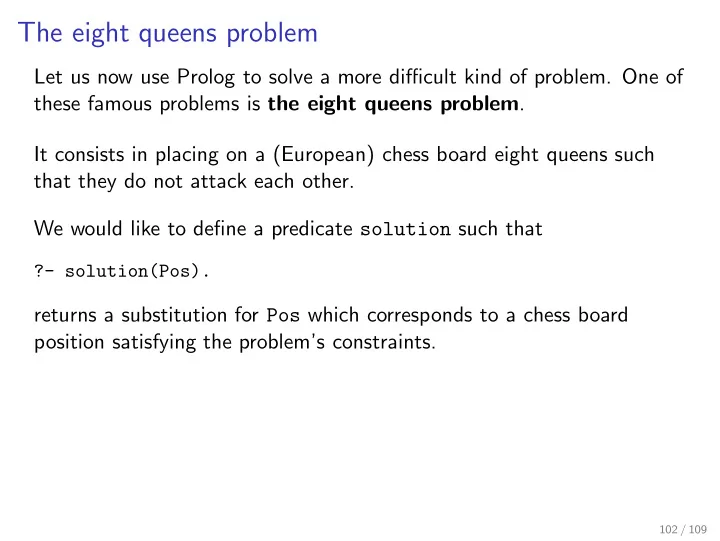

The eight queens problem Let us now use Prolog to solve a more difficult kind of problem. One of these famous problems is the eight queens problem . It consists in placing on a (European) chess board eight queens such that they do not attack each other. We would like to define a predicate solution such that ?- solution(Pos). returns a substitution for Pos which corresponds to a chess board position satisfying the problem’s constraints. 102 / 109
The eight queens problem (cont) 0 Z 0 Z 0 l 0 Z Z 0 l 0 Z 0 Z 0 0 Z 0 Z q Z 0 Z Z 0 Z 0 Z 0 l 0 q Z 0 Z 0 Z 0 Z Z 0 Z q Z 0 Z 0 0 l 0 Z 0 Z 0 Z Z 0 Z 0 Z 0 Z q Figure : A solution to the eight queens problem. 103 / 109
The eight queens problem (cont) First, we have to choose a representation for the board positions. One possibility is to model a square by two coordinates, the leftmost, down-most square being (1 , 1) and the rightmost, uppermost (8 , 8). The example in the previous slide can be modeled by the list of queens [.(1,4),.(2,2),.(3,7),.(4,3),.(5,6),.(6,8),.(7,5),.(8,1)] Keeping this idea, we choose a template solution of the form template([.(1,Y1),.(2,Y2),.(3,Y3),.(4,Y4), .(5,Y5),.(6,Y6),.(7,Y7),.(8,Y8)]). because there must be a queen on each column. 104 / 109
The eight queens problem (cont) There are two cases: 1. the list of queens is empty: the empty list is certainly a solution since there is no attack; 2. the list of queens is not empty: then it has the shape [.(X,Y) | Others] , that is, the first queen is on the square .(X,Y) and the others in the sub-list Others . If this is a solution, then the following constraints must hold. 2.1 there must be no attack between the queens in Others , i.e. Others must be a solution; 2.2 X and Y must be integers between 1 and 8; 2.3 a queen at square .(X,Y) must not attack any of the queens in the list Others . 105 / 109
The eight queens problem (cont) This is written in Prolog solution([]). solution([.(X,Y) | Others]) :- solution(Others), member(Y, [1,2,3,4,5,6,7,8]), no_attack(.(X,Y), Others). member(Item, [Item | _]). member(Item, [_ | Tail]) :- member(Item, Tail). It remains to define the relation no attack . 106 / 109
The eight queens problem (cont) Given no attack(Q, Qlist) , there are two cases. 1. if the list of queens Qlist is empty, then the relationship is true because there is no queen to attack or to be attacked by; 2. if the list Qlist is not empty, it must be of the shape [Q1 | Qsublist] , with the following conditions holding: 2.1 the queen at Q must not attack the queen at Q1 , 2.2 the queen at Q must not attack the queens in Qsublist . 107 / 109
The eight queens problem (cont) A queen does not attack another queen if they are on different columns, rows and diagonals. Finally: no_attack(_, []). no_attack(.(X,Y), [.(X1,Y1) | Others]) :- Y =\= Y1, Y1 - Y =\= X1 - X, Y1 - Y =\= X - X1, no_attack(.(X,Y), Others). 108 / 109
The eight queens problem (cont) The query has the shape ?- template(S), solution(S). Note that ?- solution(S), template(S). is wrong . Why? 109 / 109
Recommend
More recommend